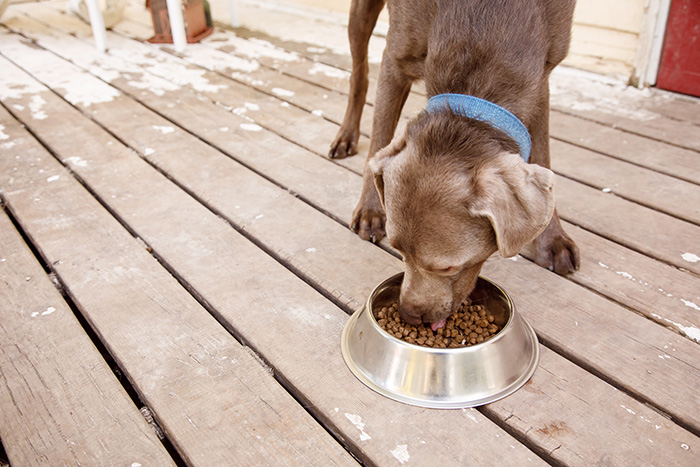Pet Food Storage

Buying dog and cat food in bulk can be a good way to save money. However, how you store that large bag of food once it is opened can significantly affect its freshness and quality. Here are some things you can do to ensure your pet is getting the best nutrition.
Check the date: All bags and cans of pet food have an expiration or “use by” date on them. It is usually stated as a “best by” or “best before” date. Be certain the date is far enough in the future that you will use up the product before that date. This is especially important if you buy from a small store that may have a low product turn over. If you buy food from an online distributor, do not assume they are checking best buy dates.
Check the packaging: Check the bag or can to be certain it has not been ripped, punctured or dented. Damage to the packaging can allow the food or some of its ingredients to degrade or spoil sooner.
Storing dry food: Regardless of the best by date, once a bag of dry food is open it will begin to degrade. Dry food should always be stored in the original bag. These bags are specially designed to protect the contents. When opening the bag, do it carefully so the top can be rolled closed and clipped and be certain to close it well after each use. The bag should be stored in a cool, dry place at less than 100°F to decrease damage to vitamins and oxidation of fats. When dry food is stored above 120°F for greater than 48 hours, damage to these ingredients can be accelerated. If you are going to store dry food in a container, it should be glass or metal. Plastic containers have an odor that can affect palatability. If using a glass or metal container, the food should still be kept in the original bag. This will serve as added freshness protection, plus you will always have the best by date available in the event you should need to refer to it. Food should always be stored up off the floor to help protect it from insect contamination and small critters. Keeping food up and out of reach will also prevent dogs or cats from accidently getting into it and overeating.
Storing canned food: In theory, a properly stored can of food can last for years. This said, it is still important to adhere to best by dates, so your pet is receiving the best nutrition possible. Cans should be stored in a dry location between 50-100°F. Once opened, canned food should be tightly covered either with a lid or plastic wrap. This will help to decrease moisture loss and transfer of odors. Plastic wraps also serve as a good moisture, air and odor barrier. In contrast, plastic storage type bags only serve as a moisture barrier. Once covered, canned food can be stored in the refrigerator at 40-45°F for 5-7 days. Do not freeze left over food as this can change the texture and taste.
Servings and bowls: Dry food can be left out for the day, without concern. Feed the amount you expect your pet to eat in a day. Any left-over food should be thrown out and replaced with fresh the next day. The bowl should be washed in hot, soapy water once or twice a week. Canned food should only be left out for a maximum of 4 hours. After that, it will dry out, spoil and become unpalatable. Bowls for canned food should be washed in hot, soapy water after each use.
Anytime you open a bag or can of food and it smells bad or “off” or your pet will not eat it, you should return it. Remember your pet has a better nose than you do. Reputable pet food manufacturers will stand by their product and offer a money back guarantee.
Using these guidelines, you should be able to provide your pet with the most fresh and nutritious food possible. Even with these guidelines you should not buy more food than you will use in 6 weeks. Buying bulk quantities of food may not be a cost savings in the long run if you have to toss it out due to spoilage or if spoiled food leads to health problems.
